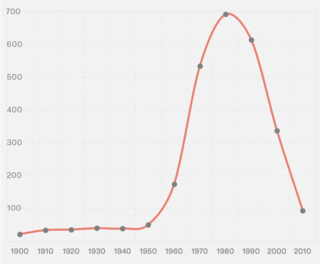Intelligence
What You Know About Serial Killers May Be Wrong
14 surprising facts about serial killers in modern day America.
Posted September 9, 2022 Reviewed by Tyler Woods
Key points
- Between 1970 and 2000—the “Golden Age of Serial Killing"—there were more serial homicides than at any other point in American history.
- Serial killers do not always fit neatly into simple, clean-cut categories.
- Over the years, we have learned more about serial killers and their psychology.

The Doodler—one of San Francisco’s most well-known cold-case murderers—is back in the news. San Francisco police recently announced a possible sixth victim.
The Doodler's modus operandi is consistent and appalling: In the mid-1970s, he targeted gay men by posing as a cartoonist who would draw sketches of his victims before a sexual encounter, followed-up quickly by attacking and murdering them. Bodies were often dropped on area beaches and in local parks, producing concern and panic among Bay Area residents. Although he has not been caught, police feel they are getting closer to solving the case.
This story is fascinating, in part, because it looks like the killer does not fit the stereotypical portrait of the American serial murderer that emerged in the 1970s and 80s (think Ted Bundy, John Wayne Gacy, David Berkowitz, etc.). Over the years, we have learned more about serial killers and their psychology. Here are 14 facts that may just surprise you:
- Serial killer IQ is related to the murder method. Data from the Radford University/Florida Gulf Coast University Serial Killer Database, a collection of thousands of serial homicides, shows that the highest average IQ scores belong to killers in the “bomb” category. Ted Kaczynski, the Unabomber, held a Ph.D. in mathematics and worked as a professor at U.C. Berkely before he removed himself from the grid and moved to a small cabin in remote Montana. Murderers of average intelligence favor poisoning, while strangulation, stabbing, and shooting are the preferred methods for those with slightly below-average intelligence. The lowest IQ scores are correlated with bludgeoning.
- There's no such thing as a serial killer prototype. Many would like to believe there is a prototypical personality profile for serial murderers, but—just like so many other features of human psychology—there are variations in personality and nuances in behavior that violate our assumptions all the time. It would be a lot easier to apprehend perpetrators if we could just crack the secret code, but a one-size-fits-all formula simply does not exist.
- Not all serial killers are insane psychopaths. Insanity is a legal term: only 2 to 4 percent of serial killers are legally insane. Generally speaking, pleading insanity is a risky defense in court because a defendant must demonstrate that they were unaware of their actions at the time of the murders and incapable of understanding the difference between right and wrong. Most serial killers are keenly aware of what they are doing, they know it is wrong, but they do it anyhow.
- Most serial killers are not highly mobile. While it is true that several high-profile serial killers are famous for traveling across the country in search of victims, most hunt in a small geographic comfort zone, close to home or work. Ted Bundy had known victims in Washington, Colorado, Utah, and Florida, but this is extremely rare, even for serial killers. Almost as rare as traveling serial killers are “place” killers. These individuals, like America’s first serial killer, H.H. Holmes, who killed his victims after they checked into his bizarrely constructed hotel near the 1893 Chicago World’s Fair, tend to kill people in a single building, like a home, hospital, or hotel.
- Not all serial killers are lust killers. Lust killers practice erotophonophilia, a homicide in which the offender searches for sexual satisfaction by killing someone. The perpetrator gains sexual arousal or gratification from the death of a human being. Many infamous killers fit into this category, including Ted Bundy, Ed Kemper, Gary Ridgway (The Green River Killer), and Dennis Rader (BTK). This is dark, disturbing, and fascinating for sure, but there are other categories of serial homicide. Offenders can be motivated by the need for power and control, or the need to carry out a mission connected with some philosophical, political, or religious platform. Those who are known to have had psychotic breaks with reality may be driven to kill by violent hallucinations, such as murderous voices.
- Many serial killers kill alone, but not all. About 1 in 4 serial killers have one or more killing partners. For example, Karla Homolka is a Canadian serial killer who, along with her husband, Paul Bernardo, raped and murdered at least three minors in Ontario between 1990 and 1992, including Karla’s own sister.
- Serial killers have dozens of victims. Some do, but most kill fewer than eight victims. In fact, the number of victims per serial killer has dropped dramatically over the past 70 years. In 1950, 38 percent of all serial killers had five or more victims. Today, the percentage of serial killers who have more than five victims is down to 13 percent. There are many reasons for this. For example, better investigative techniques, DNA, video surveillance, communication between jurisdictions, etc. all contribute to the apprehension of these individuals before they can amass obscene body counts.
- Most serial murderers kill for the same reasons. When serial offenders are finally incarcerated and interviewed, more than 60 percent report that they were motivated simply by enjoyment, financial gain, or some combination of the two. These prisoners will often give a variation of the very unsatisfying answer, “I just wanted to do it because it seemed like fun.” Other motivations identified in the study were anger, avoiding arrest, cult pressure, and attention-seeking.
- Males and females are equally likely to be victims. About 49 percent of serial killer victims are male and 51 percent are female. Some serial killers target one gender exclusively, while others, like Richard Ramirez (The Night Stalker), seemed to kill randomly. His victim list included males, females, young people, old people, and various races and ethnicities. It seems no one was spared.
- Two-thirds of victims are white, but black victims are overrepresented. The victims of serial killers track to the U.S. Census population numbers closely except when it comes to black victims. While whites make up 62 percent of the population and 67 percent of victims, black Americans, who represent 13 percent of the population, comprise 24 percent of all serial killer victims.
- More than half of all serial killer victims are under the age of 30. Only 11 percent of victims are older than 60 years. This could reflect the fact that many serial killers pursue victims close to their own age.
- Serial murder varies by geography. Washington, D.C. has historically had the most serial killings, per capita. U.S. states at the top of the list, with 5 to 6 serial killings per 100,000 residents, include Louisiana, Alaska, and Indiana.
- Serial killers are not all white and male. In recent years the majority of serial killers have been black. Nearly 17 percent are female. Serial killers vary in race, ethnicity, religion, nationality, age, gender, SES, IQ, and education.
- The serial killer peak was in the 1980s. Some researchers dub the period between 1970 and 2000, the “Golden Age of Serial Killing.” This title may be a little too cheery for many, but it does illustrate the whopping difference between this era compared to the ones before and after. There were more serial killings during this stretch of time than at any other point in American history.

Data suggests a different common thread that runs through many serial killers. Rejection and abandonment in childhood, chronic rejection from peers and potential romantic partners along with an abject sense of total abandonment from loved ones seem to contribute significantly to the creation of the serial killer mind starting at a very young age.
References
Aamodt, M. G., Leary, T., & Southard, L. (2018). Radford/FGCU Annual Report on Serial Killer Statistics: 2018. Radford, VA: Radford University.
Bennett, K., Gualtieri, T., & Kazmierczyk, B. (2018). Undoing solitary urban design: A review of risk factors and mental health outcomes associated with living in social isolation. Journal of Urban Design and Mental Health, 4:7. https://www.urbandesignmentalhealth.com/journal-4---solitary-urban-design.html
Hickey, E. W. (2013). Serial murderers and their victims (6th ed.). Belmont, CA: Wadsworth
Vorbach, L., & Bennett, K. (2020). Cortisol affords immediate action and alertness. In Shackelford, T.K., & Weekes‐Shackelford, V.A. (Eds.), Encyclopedia of Evolutionary Psychological Science. Springer, Cham. https://doi.org/10.1007/978-3-319-16999-6_1152-1


